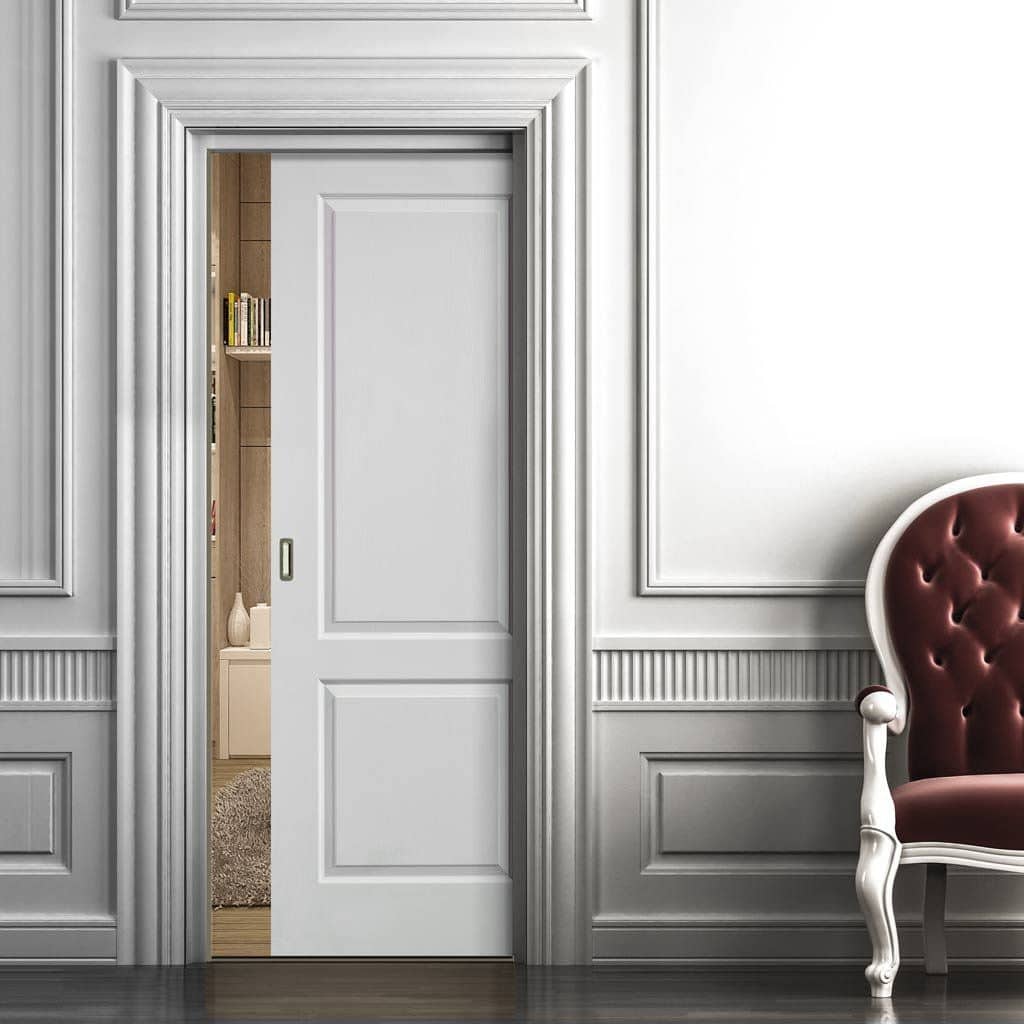Pocket doors are interior doors, typically found in the home, that save lots of space, particularly in smaller rooms. Instead of swinging out, pocket doors slide discretely into an opening in the wall across a track (typically in the ceiling).
The pocket door is popular because they free up more room since the door is tucked out of the way rather than hanging inside of the room. Double pocket doors can close off two rooms, or open up to combine rooms into one much larger space.

How can you tell if pocket doors are right for any particular space in your house? There are pros and cons to pocket doors depending on your needs and how much space you have to work with.
Table of contents
Advantages of the Pocket Door
Pocket doors are highly functional in that they’re smooth, fast, and practical. As we mentioned, you can save tons of space with pocket door hardware, especially if you live in a smaller house.
They’re also a diverse choice for any style of home decor. After all, they hide away into the wall, meaning even as you change your interior for the changing seasons, your doors have little impact on the overall ambiance.
You can combine larger rooms without having big, bulky swinging doors in the way, allowing you to transform your home from a cozy, humble abode into an open, roomy entertainment space. You can even separate entire sections of the house off from each other, and the hardware looks much more discrete.
Disadvantages of the Pocket Door
Many pocket doors can be heavier than traditional swinging doors made for indoor use. As a result, individuals with limited mobility may struggle using pocket doors, making them a poor choice anywhere in their homes.
Pocket doors also don’t seal off a room nearly as well as swinging doors. Since the pocket door slides in and out of place, it doesn’t latch and rest firmly against the frame. As a result, they can hang slightly loose and even slide ajar if the alignment, balance, or weighting is off-kilter. This means that pocket doors don’t insulate against sound, smell, or even light. More sensitive environments might be better served with traditional swinging doors.
By the way, issues with alignment, balance, and weighting can occur frequently with any kind of sliding doors. Sliding door track mounts simply wear out over time, even when built with high-quality hardware. On top of that, imperfect installation will result in doors that slide on their own. Pocket doors are just simply harder to get right, and they wear down much faster than swinging doors.
Materials Needed for Pocket Doors
Pocket door installation is a more advanced DIY project, and you’ll need several tools to get the job done. Don’t worry, if you’re a DIY pro or a professional contractor, you’ll have most or all of this stuff on hand.
For this job, you’ll need:
- Screws and finish nails
- Screwdrivers and a power drill
- Miter saw
- Nailer
- Tape measure
- An electronic level
- Drywall, drywall screws, and drywall adhesive
- Joint compound
- Wood trim, if needed
- A pocket door with hardware for installation (included in most kits)
How to Install a Pocket Door
Before you start cutting up your existing doorframe, you need to find out a few things in advance.
- Is the wall wide enough? Check the measurements of your pocket door.
- Is there any electrical wiring or plumbing in the wall you must avoid?
- Will the wall and doorframe bear the weight of your pocket door?
- Does your pocket door frame kit include a header, or do you need to make one?
Start by taking off the existing door. Remove the hinges and all of the other hardware around the doorframe. You can cut into the drywall next to the doorway to make the pocket. It must be twice as wide as the pocket door itself, or else the door won’t tuck all the way into the wall.
Cut the header to the length of your frame and attach it. Then attach the track itself. The most important part of this process is keeping the track and header hardware completely level. Be aware that if the room isn’t on a level plane, or as the house settles, you may need to relevel your track to account for some slant.
Remove the studs from the wall where the door is going to slide in. You’ll add in split studs here, which can usually be installed in the plate in the bottom of the wall frame. These keep the wall supported and open up space the door may use to slide right into place. Level the split studs, and then connect them to the header you just assembled. You may want to consult professional help if your wall doesn’t have a metal frame available for you to use inside the floor.
You’re almost ready to attach the door. However, it’s easier to do work on the door itself before it’s hung. Install the lock, attach any door hardware, and perform any staining or painting first. Once all of these preparatory steps are done, you’re ready to hang your pocket door!
There are tons of pocket doors available on the market for your next project. Next time you’re updating the design in your home, make sure to consider a pocket door for any area where you want to save a little room.
